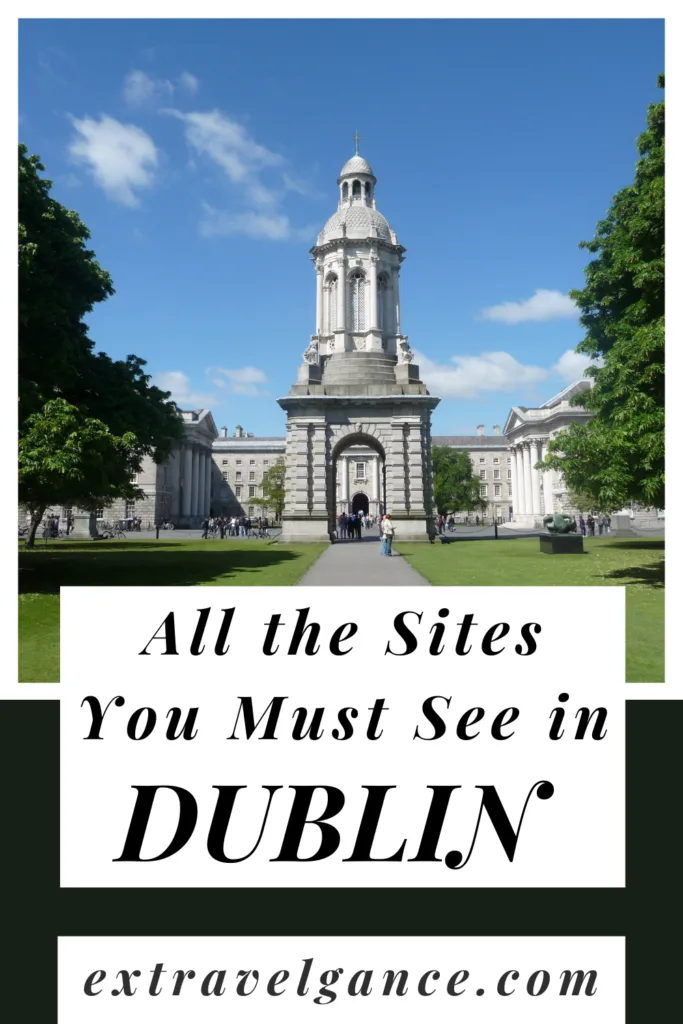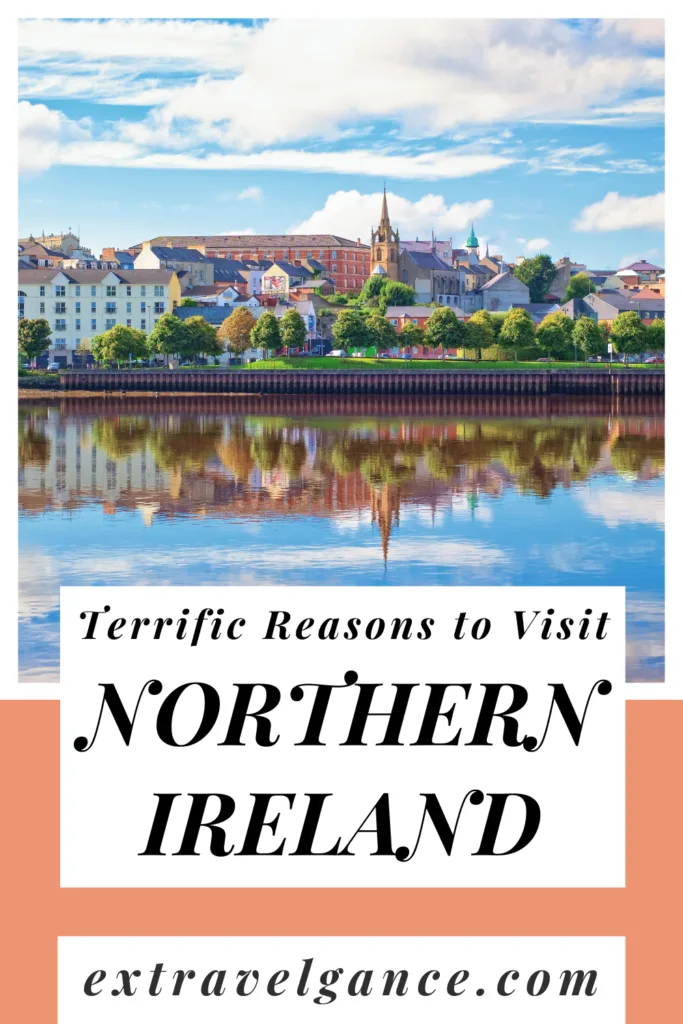
Northern Ireland features dramatic landscapes, vibrant cities, immersive culture, and rich historical sites. Despite a troubled past of political unrest, Northern Ireland is now a safe place to visit with so much to offer.
Note: we may earn a commission from the affiliate links below.
Amazing Scenery
Northern Ireland offers a diverse array of landscapes, from rugged coastlines to misty mountains to lush green valleys. Shaped by volcanic activity and glacier melts, the result is a striking mix of terrain that is both ancient, yet alive. Here are some top sites to include on your itinerary.

Giant’s Causeway
Formed by ancient lava flows, Giant’s Causeway features 40,000+ hexagonal basalt columns jutting up from the ground. Legend has it that this UNESCO World Heritage Site was created by the mythical Irish giant, Finn McCool. When Scottish giant Benandonner threatened to attack, Finn tore chunks from the coastline and used the rocks to create a path over the sea to reach Scotland. When Finn arrived, he discovered the Scottish giant was much larger than himself. Pursued by Benadonner, he made a hasty retreat back over the path. When Finn arrived home, his wife disguised him as a baby. Benadonner saw him and thought that Finn’s father must be huge to have a baby so big. So he raced back over the path to Scotland, tearing it up as he went.
Start your visit at the Visitor Centre to learn about the scientific explanation for the terrain as well as more about the legend of its creation. Then take an easy Blue Trail or hop on a shuttle bus to go down to the coastline. You can walk on the stones, hopping from column to column. If you like to hike, there’s a moderate Red Trail cliff-top walk offering panoramic sea views. While you are there, make sure to keep an eye open for wildlife such as seabirds and dolphins.
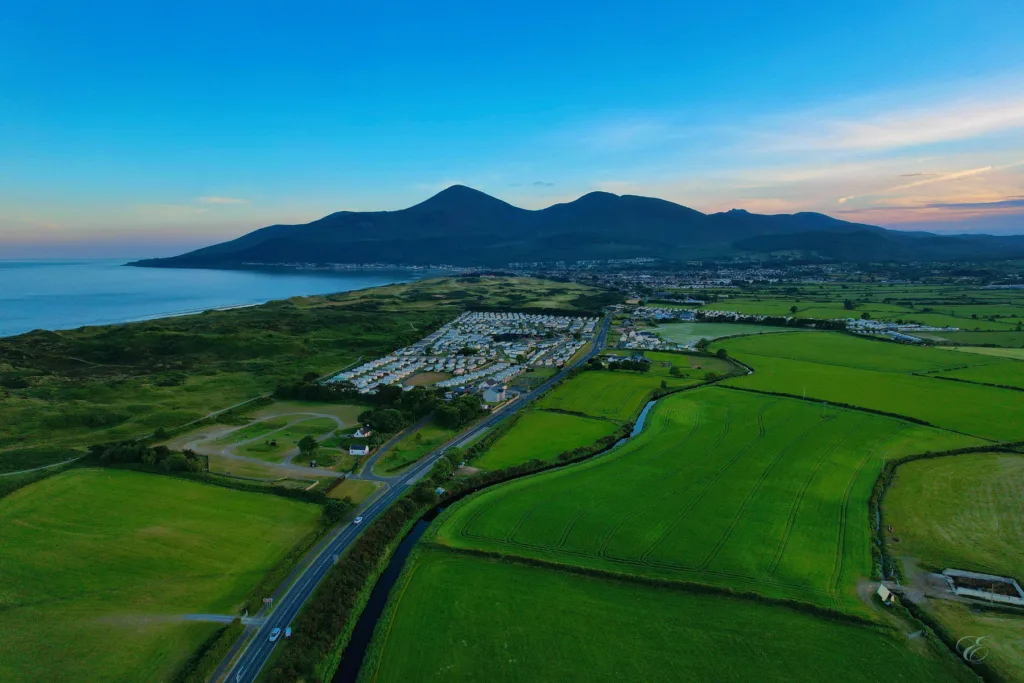
Mourne Mountains
Lying between Dublin and Belfast are the Mourne Mountains. These granite peaks are known as a hiker’s paradise offering spectacular trails. Hike the Glen River trail to the peak of Slieve Donard, the tallest mountain in Northern Ireland at 2,789 feet high.
If you are ambitious, you can walk the Mourne Wall. This 22-mile historic stone wall crosses 15 mountain summits. If you are less ambitious but still want to see the wall and some amazing views, try the Doan Summit via Banns Road trail. But perhaps most of us would prefer not to hike up any mountains. That’s OK! You can experience the gorgeous scenery from the comfort of a car on the Mourne Coastal Route!
Tollymore Forest Park is another place where hikers can find some great trails. Some notable features of the park are the Shimna River teeming with birds and mammals, 200+ year old stone bridges, a towering cedar lined welcome path, the Hermitage stone memorial, and the Clanbrassil Barn dating from 1757. Camping is available in the park.
Castelwellan Forest Park is home to a stunning castle and offers a ton of great outdoor activities like hiking trails, mountain biking, water sports, and horse-riding. The Castelwellan Peace Maze is one of the world’s largest permanent hedge mazes. It will take you about 40 minutes to make your way through it. If you love gardens, make sure to visit Castlewellan Arboretum and Annesley Gardens. And if you have kids in tow, let them run off some steam at the Animal Wood playpark with animal themed play structures.

Causeway Coastal Route
As you travel from Belfast to Derry/Londonderry, take the Causeway Coastal Route. It hugs the coastline and is known as one of the most beautiful road trips in the world. The direct route is about 120 miles, but you can take nine scenic loops off the main causeway for a total of 256 miles. Along the way you will see castles, cliffs, charming hamlets, fishing villages, and much more! It would take 2-3 days to explore all there is to see and do on the causeway.

Things to See & Do Near Belfast
Just north of Belfast lies the 12th century Norman Carrickfergus Castle. If you are a castle lover, it’s worth a stop. If you like adventure, drive a little further to the Gobbins Cliff Path. Here you can walk along the cliffs on a challenging path that includes tunnels and bridges over crashing waves. If you plan to do this, make sure to pre-book it and know that it’s weather dependent.
A bit further along the route will take you through charming villages of Glenarm, Cushendall, and Cushendun. These towns are all gateways to a lush valley called Nine Glens of Antrim. Near Cushendun you will also find Cushendun Caves, a Game of Thrones filming location.

Sites Near Giant’s Causeway
Continuing north you will find the Carrick-a-Rede Rope Bridge. The bridge is 100 feet above the Atlantic Ocean and connects the mainland to Carrick-a-Rede island. If you want to experience it, make sure to pre-book it. If you are driving the Causeway Coastal Route May through July, it’s worth it to take a short ferry ride from Ballycastle to Rathlin Island to see puffins. Year-round, the island is also great for bird watching, hiking, and just relaxing in nature.
Nearby is Giant’s Causeway (covered above). And right next to that is Dunluce Castle, a clifftop ruin great for a quick photo stop. You are probably thirsty by now, so it’s great that Bushmill’s Distillery is also nearby. You can take a tour or taste the product of Ireland’s oldest licensed whiskey distillery. After (or instead of) all of this, you may just want a relaxing day at the beach. If so, Benone Strand is a great place to go. Near the beach, you can also visit Mussenden Temple and Downhill Demesne. This 18th century estate has gardens to explore and the temple perched on a cliff makes for a great photo op.
Vibrant Cities
Cities in Northern Ireland tend to be on the smaller side, which is ideal for a traveler. Even the largest cities in the country will feel charming and welcoming.

Belfast
Belfast is the capital of Northern Ireland and is the largest city with about 350,000 inhabitants. The city is colorful with street art and is brimming with live music and pubs full of character. The biggest tourist draw is the Titanic Belfast Museum where the legendary ship was built and launched on its fateful journey. Exhibits tell you not only the familiar story of those who sailed on the ship, but those who built it. Another must-do activity is taking a tour to learn more about the time of the Troubles (more on this below), seeing political murals, and visiting the Peace Walls.
Other sites of note are the 19th century Crumlin Road Gaol (prison), City Hall, and Botanic Gardens. The Ulster Museum has something for everyone with diverse exhibits on art, science, and history. You can get a great view of the city from Belfast Castle in Cave Hill Country Park.
Look no further than Cathedral Quarter for cozy pubs, live music, great restaurants, boutiques and art galleries. And if you happen to visit the city Friday-Sunday, check out St. George’s Market for fresh produce, live music, and great souvenirs.
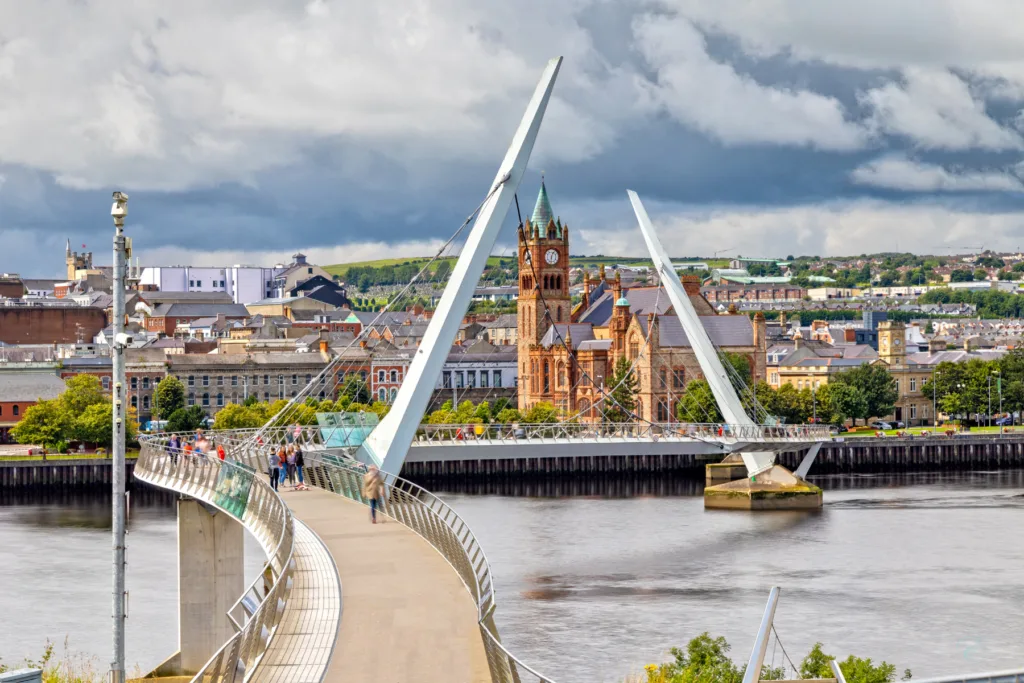
Derry/Londonderry
Legally called Londonderry and referred to as Derry by the locals, this city is the second largest in Northern Ireland with about 85,000 residents. The city name has a long, controversial history dating back to British colonialism in the 17th century. As a tourist, just refer to it as Derry like the locals.
Derry has Europe’s best-preserved medieval walls completely encircling the historical city center. You can walk around the 400 year old walls from moat level or at the top of the ramparts. The walls are about one mile in circumference. To learn more about the city, take one of the many walking tours available. As you explore town, you will see iconic landmarks like the Guildhall, the Peace Bridge, and St. Columb’s Cathedral.
Derry has several great museums. The Museum of Free Derry has multi-media exhibits on the civil rights movement in Ireland and the creation of Free Derry in the 1960s and 1970s. Nearby, explore the Bogside Murals that tell the story of the Troubles from a local perspective. The Tower Museum has permanent exhibits on the history of the city and the warship La Trinidad Valencera and its role in a 16th century war between England and Spain. If you are a fan of the Netflix show Derry Girls, visit the Tower Museum’s Derry Girls Experience. Here you will see recreated sets and show memorabilia. And the Siege Museum provides an overview of the history of the Siege of Londonberry and of the Associated Clubs of the Apprentice Boys of Derry.
Shoppers rejoice! Just outside the old city walls lies Craft Village. Here you will find a reconstructed 18th century street and 19th century square along with 70+ local crafters selling their wares.
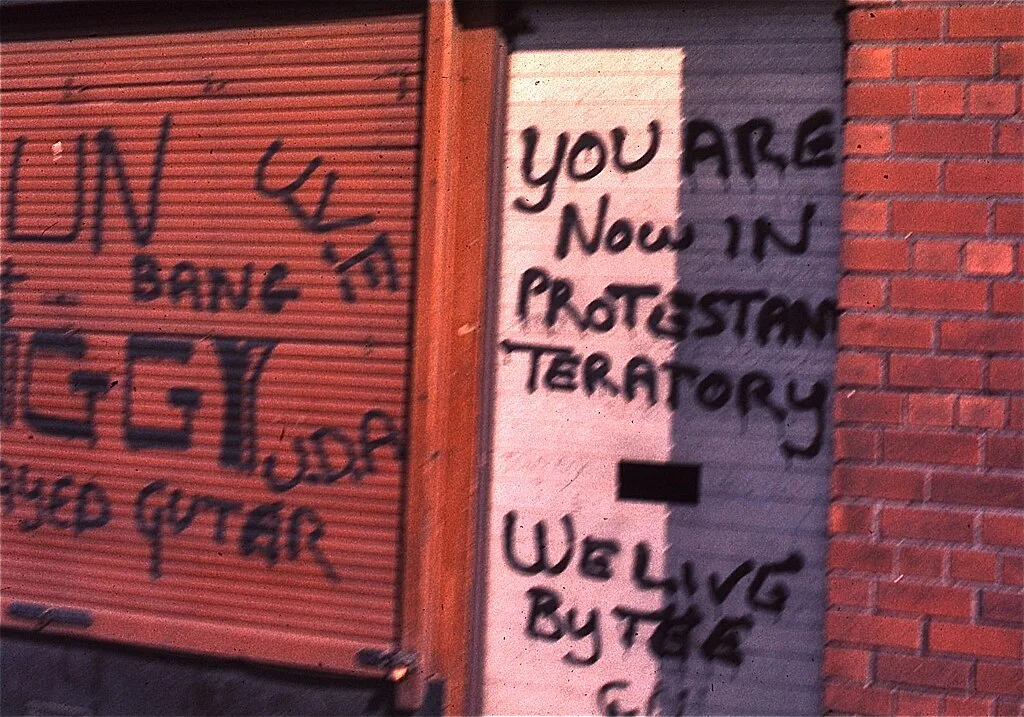
Rich & Complex History
Throughout this post, I’ve referred to a history of political unrest called “The Troubles.” If you paid attention to news in the 1990s, you may already know what that is. But if you are like me, you have a vague recollection of violence regarding religion happening in Ireland, but you really aren’t quite sure what it was all about. You may wonder why Ireland and Northern Ireland are two different countries. Why is Ireland in the EU while Northern Ireland is in the UK? And what about before the 1990s? So here’s my attempt to explain Irish history in a nutshell!
Early History
Originally, Ireland was home to pagan Celtic tribes who believed in many gods and goddesses led by Druid religious leaders. By the 5th century, many Irish were Christian based on the influence of Catholic missionaries like St. Patrick. Early on, Ireland wasn’t one country. It was a patchwork of kingdoms until invaded by the Normans in the 12th century. At this point, Ireland was under the rule of Great Britain.
British Rule (1169-1801)
British rule wasn’t readily accepted by the Irish, and uprisings and resistance movements were common. In the 16th century, England sent Protestant settlers to settle in the northern part of Ireland to make that part of the country friendlier to the current king, King James I. This created an ongoing religious and cultural divide. The north part of the country was mostly Protestant and the south part mostly Catholic. During this time, Ireland could be considered a colony of England. It wasn’t until 1801 that Ireland officially became part of the United Kingdom.
Irish Independence (1916-1923)
In 1916, Irish nationalists engaged in a failed armed rebellion in Dublin that is now known as Easter Rising. English’s harsh response sparked public sympathy for the independence movement. Then in 1919, the Irish Republican Army (IRA) officially began a guerrilla campaign against British forces. Chaos reigned for several years, and both sides agreed to a truce in 1921. The result was the creation of a self-governing Irish Free State and allowing Northern Ireland to remain part of the UK. The treaty led to the Irish Civil War in 1922-23, and the result was the Republic of Ireland (mostly Catholic) becoming an independent country and Northern Ireland (mostly Protestant) remaining part of the UK.
The Troubles (1960s-1998)
For years after the partition in 2021, Catholics living in Northern Ireland faced discrimination in housing, employment, and voting. By the 1960s, Catholic civil rights groups were inspired by the U.S. Civil Rights Movement. They began peaceable protests for equal rights. These protests were met with police violence and clashes with loyalists groups. By 1969, the British Army was sent in to manage the situation. Over time, paramilitary groups were formed. The IRA wanted Northern Ireland to merge with the Republic of Ireland while several loyalists groups wanted to remain separate.
Violence continued for decades, with widespread bombings, riots, and shootings in Northern Ireland, the Republic of Ireland, and even spilling into England at times. Notable events include bombings of Birmingham and Omagh, hunger strikes like that of Bobby Sands in 1981, and several high-profile assassinations. And in 1972 British troops killed 14 unarmed Catholic protestors in Derry, now known as Bloody Sunday. Overall, more than 3,500 people were killed during the conflict.
By the 1990s, political efforts to end the violence began. In 1998, the Good Friday/Belfast Agreement was signed. It created a power-sharing government in Northern Ireland where unionists (pro-UK) and nationalists (pro-Irish unity) share political power. It also established several entities designed to strengthen ties between the Republic of Ireland, Northern Ireland, and the rest of the UK. The agreement confirms that Northern Ireland is part of the UK unless a majority votes otherwise in a referendum. It also disarmed the paramilitary groups and called for police reform.
Lingering Issues Today
The Good Friday/Belfast Agreement largely ended the violence, but tensions exist to this day. People identify strongly as either a Unionist/Loyalist (mostly Protestant) and want Northern Ireland to remain part of the UK or as a Nationalist/Republican (mostly Catholic) who want a united Ireland. Brexit caused Northern Ireland to leave the European Union (EU) along with the UK, but the Republic of Ireland remains in the EU. A provision was made to keep Northern Ireland in the EU’s single market for goods to avoid a hard border between the republic and the north. But this solution angers unionists who see it as a separation from the UK.
Perhaps most noticeable to the traveler is the fact that some communities are segregated by religion and political identity. You will see Peace Walls dividing Catholic and Protestant neighborhoods in Belfast and other cities. And you might hear discussion about the possibility of a referendum for Irish unity. As of 2022, 40% of Northern Ireland’s voters identify as neither unionist or nationalist while only 25% identify as nationalist. And 31% support reunification, down from 55% in 1998. Perhaps someday we’ll see a reunified Ireland.

Immersive Culture & Local Flavor
Where might you find the locals discussing politics? The local pub, of course! There’s one on every corner where you can listen to live music, enjoy the local cuisine, and savor a pint of Guinness or a dram of Bushmills whiskey. The pub is the best place to truly interact with locals, engaging in conversation or what they call “craic” (pronounced “crack”).
The word craic evolved from the English word crack which to the 18th century English and Scottish meant conversation, news or gossip. When brought to Ireland, the spelling changed to reflect the Gaelic language. The meaning of the word also evolved to describe the experience of conversation, not just the conversation itself. Craic to the Irish involves storytelling, humor, liveliness, and a deep connection with others.
North Ireland Folklore
When you interact with the locals, you are sure to hear great storytellers eager to share Irish myths and folklore. Ask them about the giant Finn McCool (of Giant’s Causeway), Ireland’s tragic lovers Diarmuid and Grainne,the Selkie seal people, or even Dracula’s Irish origins. There is also folklore about fairies, pirates, gods and goddesses, and even real-life saints like St. Patrick.
Northern Ireland Eats
Looking for some hearty Northern Irish fare? Ulster Fry is Northern Ireland’s approach to breakfast with bacon, sausage, black pudding, eggs, mushrooms, tomatoes, soda bread, and potato bread. Or try a Belfast bap, a crusty soft bread roll filled with sausage, bacon, and egg. For lunch or dinner, there’s traditional Irish stew, Ulster seafood chowder, oysters from Strangford Lough, and smoked salmon. Order champ as a side dish. This is made from potato, milk, butter and scallions. And don’t miss the great breads like soda bread, potato bread, and wheaten bread. For dessert, try Fifteens which is made from digestive biscuits, glace cherries, marshmallows, condensed milk, and dried coconut. Another option is Yellowman, a type of toffee made with sugar, vinegar, and baking soda. End your meal with Irish coffee made with Irish cream liquor, a shot of whiskey, and topped with whipped cream. Yum!
What are you most looking forward to during your trip to Northern Ireland?
Tell us below! You can also contact us and follow us on Facebook, Instagram and Pinterest so you never miss a post!

